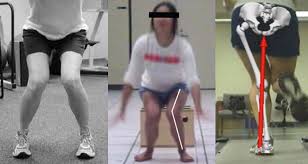Laurie's Blogs.
Nov 2018
Glutes & the Knees (Stifles) - Where do you focus?

In my search for blog topics, I was pointed in the direction of gluteal weakness and patellar issues. In particular, there seems to be an association between knee pathology and hip weakness, and a movement towards and bodies of research that support strengthening of the gluteals and other hip muscles as a way to treat the knee problems.
I came across a pod cast that reviews research articles and was directed to the following research paper.
Zhang ZJ, Lee WC, Ng GYF, Fu SN. Isometric strength of the hip abductors and external rotators in athletes with and without patellar tendinopathy. Eur J Appl Physiol. 2018 Aug;118(8):1635-1640.
CONCLUSIONS:
Athletes with Patellar Tendinopathy have decreased isometric strength in their hip abductors and external rotators when compared with controls. In subjects with unilateral Patellar Tendinopathy, decreased isometric strength in the hip abductors is associated with greater intensity of pain and lower functional scores. Results of this study implied that hip muscle assessment and strengthening should be included for reconditioning and rehabilitation in athletes with Patellar Tendinopathy.
I know, I shouldn’t just give you the conclusion. I’m a stickler for saying “It’s important to read the whole paper.” But for this purpose, I’ve just given you the conclusion. Anyways, yes, there is a correlation. The pod caster I was listening to (https://www.tendinopathyrehab.com) brought forth that the researchers didn’t make any inference as to why the correlation existed. Was it pain that reduced the whole of the lower leg function? Was there a reflexive inhibition? Was it related to body mechanics? Things to ponder late at night!
So, after listening to the podcast, I hopped on PubMed to start searching for other bits of research. To my surprise, I came up with one done by an old high school friend of mine!
Ferber R, Bolgla L, Earl-Boehm JE, Emery C, Hamstra-Wright K. Strengthening of the hip and core versus knee muscles for the treatment of patellofemoral pain: a multicenter randomized controlled trial. J Athl Train. 2015 Apr;50(4):366-77.
I’ll give you a bit more on this one. It’s pretty interesting. It was a multi-centred trial that studied 199 patients.
CONTEXT:
Patellofemoral pain (PFP) is the most common injury in running and jumping athletes. Randomized controlled trials suggest that incorporating hip and core strengthening (HIP) with knee-focused rehabilitation (KNEE) improves PFP outcomes. However, no randomized controlled trials have, to our knowledge, directly compared HIP and KNEE programs.
OBJECTIVE:
To compare PFP pain, function, hip- and knee-muscle strength, and core endurance between KNEE and HIP protocols after 6 weeks of rehabilitation. We hypothesized greater improvements in (1) pain and function, (2) hip strength and core endurance for patients with PFP involved in the HIP protocol, and (3) knee strength for patients involved in the KNEE protocol.
RESULTS:
Compared with baseline, both the visual analog scale and the Anterior Knee Pain Scale improved for patients with PFP in both the HIP and KNEE protocols (P < .001), but the visual analog scale scores for those in the HIP protocol were reduced 1 week earlier than in the KNEE group. Both groups increased in strength (P < .001), but those in the HIP protocol gained more in hip-abductor (P = .01) and -extensor (P = .01) strength and posterior core endurance (P = .05) compared with the KNEE group.
CONCLUSIONS:
Both the HIP and KNEE rehabilitation protocols produced improvements in PFP, function, and strength over 6 weeks. Although outcomes were similar, the HIP protocol resulted in earlier resolution of pain and greater overall gains in strength compared with the KNEE protocol.
So, you could rush out and say, I’m going to only strengthen the hip and core for everything. However, to be fair, the differences between the groups was small in regards to pain management. As well, it makes sense that the group the strengthened the hip muscles had better hip strength and ‘posterior core’ endurance.
Here’s what I’m going to take away from both of these articles.
- Knee Pain (and in these cases, we’re just looking at patellar tendinopathy) is associated with weakness of the hip musculature.
- So, go ahead and plan on doing some strengthening of the hip when there is a knee pathology / knee pain.
- In regards to pain and function, you could do either an isolated hip strengthening program OR a knee strengthening program.
- I’d do a bit of both!
There you go! I hope this information fills an empty spot in your brain with a bit of fun and useful knowledge


